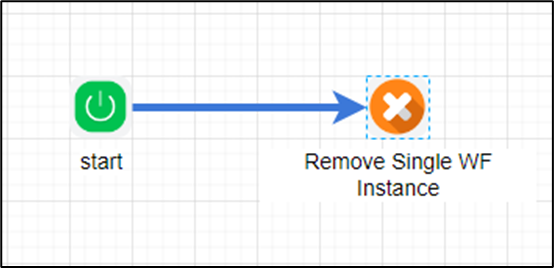Description:
This step removes the workflow instance by its instance ID, during runtime.
Note: This step is to be executed only when necessary.
Inputs
- instanceID—id of the instance
Returns
- True – step executed successfully
- False – step failed to execute
Usage:

Example:
Let’s build and execute the “removeWorkflowInstanceDef” example.
- Create a new definition called “removeWorkflowInstanceDef” and open the definition in designer mode.
- Drag a “removeWorkflowInstance” step to the canvas.
- Connect the dots between the “Start” and “removeWorkflowInstance” steps, as shown above.
- Navigate to the Process - Instance page. Select any process instance and take note of the instance ID.

- Click the "removeWorkflowInstance" step to configure its "Required" properties. Provide a name for the step. Provide the workflow instance ID to be removed during runtime. Click the Save button. Note: Click the "AI Predict" button for the Copilot to add new process steps that match your process description.

- The “Logging” setting configuration is necessary for documentation and also measures the workflow progress and the percent complete. This is achieved by configuring the step state and percent fields individually, as shown in the images below. Configure the “Logging” using the following properties.

- Save the process definition, create a new instance, and then execute it. This step removes the workflow instance ID as configured. Navigate to the Process—Instance page. Search for the workflow instance ID to notice that it has been removed.

Definition Sample:
You may download the sample definition(s) from the link here and later import them (drag-and-drop) to your FlowWright Process Definition (XML file) or Form Definition (HTML file) page.
NOTE: Please verify and complete the process steps for any missing configurations, such as file path references and database connections, after import. Then, save the definition to confirm the changes.